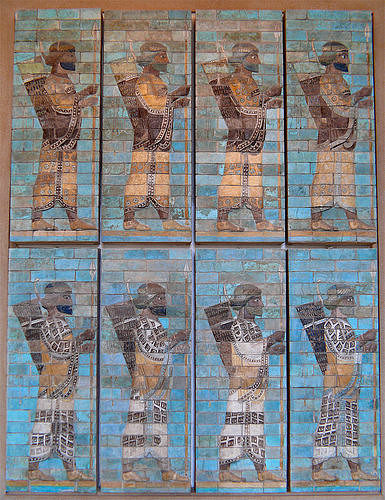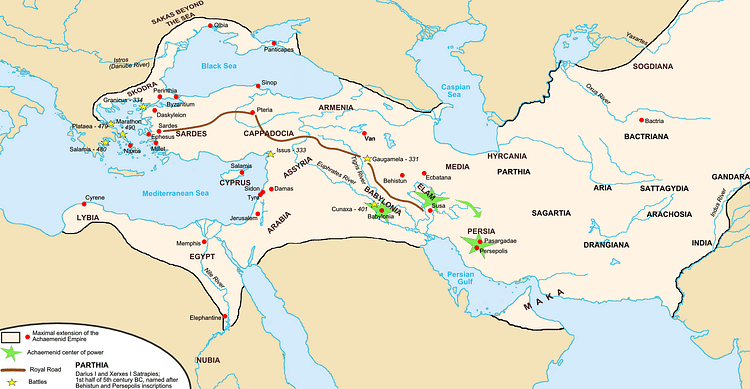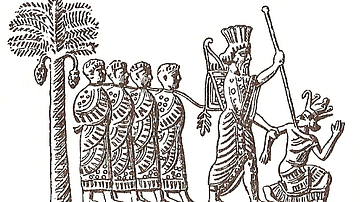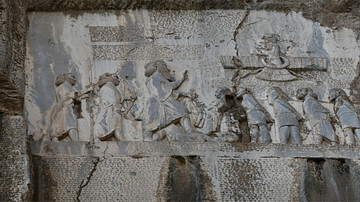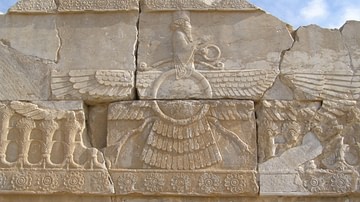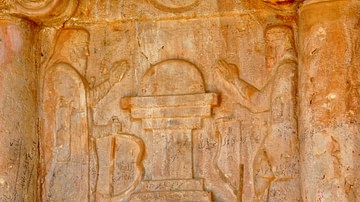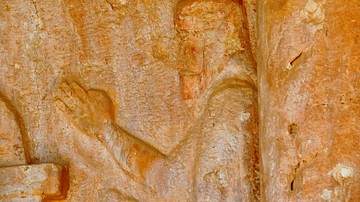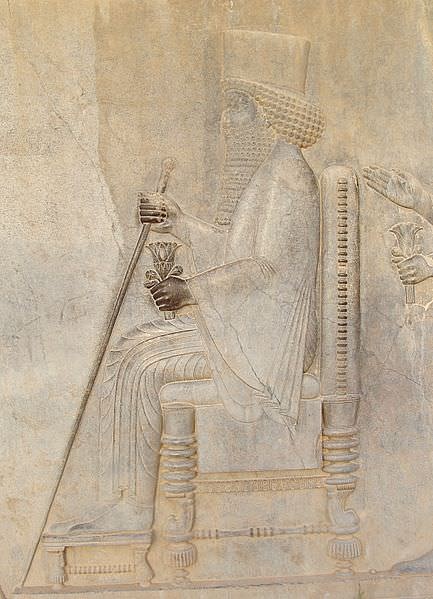
Darius I (l. c. 550-486 BCE, r. 522-486 BCE), also known as Darius the Great, was the third Persian King of the Achaemenid Empire. His reign lasted 36 years, from 522 to 486 BCE; during this time the Persian Empire reached its peak. Darius led military campaigns in Europe, Greece, and even in the Indus valley, conquering lands and expanding his empire. Not only resuming to military prowess, Darius also improved the legal and economic system and conducted impressive construction projects across the Persian Empire.
Rise to Power
The most important primary sources, that tell us about his life and reign, are his inscriptions, the most famous example being the trilingual inscription, in Akkadian or Babylonian, Elamite, and old Persian, carved on the Bisitun (Behistun) rock relief from the village of the same name and from his palace at Persepolis. Also, accounts about his reign were chronicled by the Greek historian Herodotus.
Darius was born in c. 550 BCE, the oldest son of Hystapes and Rhodugune. The Behistun Inscription mentions that his father occupied the position of satrap (Persian governor) of Bactria and Persis during the reign of Cyrus the Great (559-530 BCE) and his son, Cambyses (530-522 BCE). During the reign of Cambyses, Darius held the position of spearman (doryphoros) and accompanied the king in his campaign to Egypt between 528 and 525 BCE. Before leaving for Egypt, Cambyses named Patizithes as custodian of the royal palace in his absence. Patizithes saw this situation as an opportunity to gain power. He set up his own brother, Gaumata, as a false king under the name of Bardiya or Smerdis, Cambyses' brother, becoming the new ruler in 522 BCE. Cambyses II returned to his country seven months later only to find that he could not take his throne back. Some historical sources say he took his own life as he was unable to defeat the impostor king and his supporters, while other tell us he fell during the marches through Syrian Ecbatana or through Damascus.
The false king's reign did not last long. Herodotus tells us that Phaedymia, the daughter of Cambyses' uncle, Otanes, found out that the ruler is not Cambyses' brother. Her father, after learning the truth, quickly assembled a group of conspirators which included Hydarnes, Intaphrenes, Megabyzus, and Darius, who at the time was still the king's lancer. Gaumata was finally assassinated, leaving the Persian empire without a leader; the conspirators had to decide the future of the empire. Otanes opted out, wanting only special privileges for his family, oligarchy was suggested by Megabyzus, while Darius voted for a monarchy. Being unable to settle the matter at hand, all of them agreed on a contest, where the winner would take the throne. All of them would meet the next morning, each on his horse, and the first horse to neigh at the sunrise would be named the new king. Herodotus tells us that Darius cheated; supposedly it was his servant, Oebares, who made the horse neigh by letting the animal smell his hand that he had previously rubbed over the genitals of a mare. In any case, the horse's neigh accompanied by lightning and thunder from a storm convinced the others to accept Darius as the new king in 522 BCE.
Even though Gaumata was a false ruler, only a portion of satrapies recognised Darius as their king, after his coronation, in 522 BCE, such as Bactria and Arachosia. Others saw the false king's death as a chance for independence. Revolts broke out across many regions of the empire, including Persis, Media, Parthia, Assyria, Babylon, and Egypt, and only with aid of his army and personal entourage did Darius manage to quell these conflicts. These events are chronicled in great detail in his inscriptions, translated by Herbert Cushing, which also serve as a warning for future kings:
Says Darius the king: O thou who shalt be king in
the future, protect thyself strongly from Deceit;
whatever man shall be a deceiver, him who deserves
to be punished, punish, if thus thou shalt think " may
my country be secure." (30)[...]
Says Darius the king: O thou who shalt be
king in the future, whatever man shall be a deceiver
or a wrong-doer (be) not a friend to these; punish
(them) with severe punishment. (33)
Military Campaigns
Darius' rule was marked by vast military expeditions. After consolidating his power at home, he set off to secure the lands of Egypt, which had been conquered before by Cambyses, and in 519 BCE he incorporated a large part of Egypt into his empire. The following year, in 518 BCE, he conquered parts of India, namely northern Punjab as his inscriptions testify. Herodotus adds that India was the 20th satrapy of the empire and also that parts of the Indus valley also fell victim to Persian warfare.
The next significant campaign was in European Scythia in 513 BCE. Historians have proposed several theories in an attempt to clarify the objective of this campaign. They range from simple military conquest to a more propagandistic motive, revenge for a previous conflict during the reign of Cyrus where the Scythians had attacked Medes. Another possible reason is that Darius wanted to conquer the western Greek lands and the Scythian campaign was supposed to threaten the Greeks into surrender.
However, Darius faced unforeseen difficulties. The Scythians evaded the Persian army, using feints and retreating eastwards, all the while laying waste to the countryside. The king's army chased the enemy deep into Scythian lands, where he sent word to their ruler, urging Idanthyrsus to fight or surrender. As Idanthyrsus refused to do either, the chase resumed. In the end, the campaign halted after a few weeks when sickness and deprivation had taken its toll on the Persian army. The march halted around the banks of the Volga river and then headed towards Thrace, where Darius ordered his general Megabyzus to subjugate the region.
Besides bringing Thrace under Persian influence, Megabyzus also conquered the neighbouring Greek cities. He sent envoys to Macedonia where Amyntas, the king of Macedonia, became a vassal of the empire. Meanwhile, Darius solidified his hold in Ionia and the Aegean Islands through appointments of Greek natives as city rulers or tyrants.
Greco-Persian Wars
In 499 BCE, Aristagoras, the tyrant of Miletus, convinced the satrap Artaphernes to sponsor a campaign against Naxos. Darius gave his consent and named Megabates, Artaphemes's cousin, as commander of the Persian army. They were supposed to be supported and supplied by Aristagoras, but a quarrel between Megabates and Aristagoras resulted in the former betraying them and informing the Naxians of their plans, sabotaging the campaign. Finding himself without help, Aristagoras decided to revolt against the Persians. Seeking other allies, although he failed to acquire the support of Sparta, he managed to secure the aid of Athens and Eretria, both providing troops and ships.
After six years of conflict, during which Sardis, Cyprus, and the Hellespont were attacked, the Persian army defeated the rebels at the Battle of Lade in 494 BCE where most of the Athenian fleet was destroyed. Undeterred, Darius gathered his army, planning to conquer Athens. His army consisted of infantry and cavalry, led by the general Datis. They marched from Susa to Cilicia, where ships carried them across the Aegean Sea to the island of Samos. Here they joined up with an armed force from Ionia and sailed north, to Athens.
Meanwhile, the Athenians started to prepare for war. Envoys were sent to Sparta, but after gathering allies, the Greek force was still only 10,000 strong, facing 100,000 Persians. Outnumbered, the Greek generals needed a brilliant strategy. Two of them advised facing the enemy from within the safety of the city gates, but Miltiades convinced them that a direct attack would be a better choice. They agreed, on the condition that Miltiades would lead the army into the battle.
The two opposing armies met on the fields of Marathon in 490 BCE. The Persian army, though heavily outnumbering the Greek army, was slow and overconfident. The Greeks took advantage of this situation; as the two armies approached each other at a casual pace, the Greeks suddenly broke into a sprint. This caught the Persians off guard, and before they knew it they were forced to battle in full hand-to-hand combat. After a few hours of battle, the Persian ranks broke, many of them running towards the safety of the ships or to the nearby mountains. 6,000 Persians fell, while the Greek army lost only 200 men. The marble blocks which the Persians intended to use for the monument they were going to erect after the battle, was instead used by the victorious Greeks to build a monument for their fallen comrades. This blow was seen as an insult by Darius, who chose to fight on and prepared for another invasion. This plan, however, never came to fruition due to his death in 486 BCE.
Government
The Persian Empire witnessed many improvements during Darius' reign. He established 20 provinces or satrapies, with an archon or satrap assigned to each. Neighbouring regions paid a fixed tribute; a fair amount was stipulated by a commission of Darius' trusted officials.
He also improved the legal system of the Persian government, using the Babylonian Hammurabi as a model and copying some of his laws completely. The laws were enforced by the judges of the empire, who needed to be incorruptible. Darius removed the previous native officials, replacing them with new people loyal to him. While the punishments may seem brutal today, ranging from mutilation to blinding, fairness was not omitted as punishment depended on the nature and severity of the crime. The new system proved to be popular, even after Darius's death, some laws were still in use in 218 BCE.
In the matters of religion, it is well known that Darius was an adherent of Zoroastrianism or at least a firm believer of Ahura Mazda. This we can see in his inscriptions, where he attributes his success to Ahura Mazda, and in his legal system where all laws were created in the name of the Zoroastrian god. In the lands that were under Persian control, all other religions were tolerated as long as they remained submissive and peaceful.
Economy & Building Projects
During his reign, Darius undertook impressive construction projects across the empire. In Susa, he built a palace complex in the northern part of the city, which became his favourite residence. A grand project in Persepolis followed; the palace complex included a military quarter, treasury, the king's quarters and guest house. Besides the palaces, Darius also finished previously incomplete construction projects of Cyrus in Pasargadae. In Egypt, he built many temples and restored those that had previously been destroyed.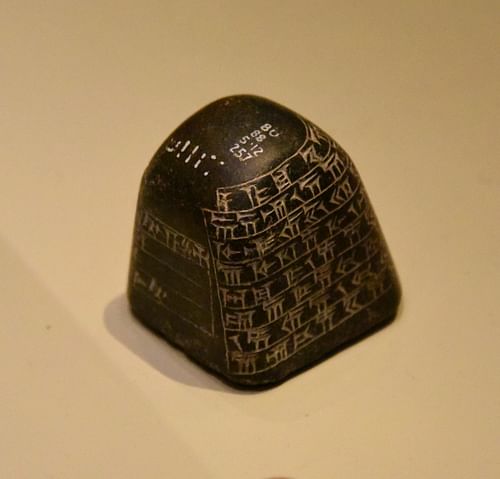
Darius introduced a new universal currency, the darayaka, sometime before 500 BCE. This innovation made it easier to collect taxes on land, livestock, and marketplaces, which led to improved revenues for the empire. To further improve the economy and help traders, a new standardised system of weights and measures was introduced.
Death & Legacy
After the defeat at Marathon, Darius did not want to give up on his dream to conquer Greece. He vowed to gather an even larger army, this time leading it personally, to fight the Greeks. After three years of preparing, during which he became ill, a revolt broke out in Egypt that only worsened his condition. Darius died in October 486 BCE; his body was interred at Naqsh-e Rustam in a tomb prepared by him beforehand, a custom of Persian kings. After his death, the throne was inherited by his eldest son from his marriage with Atossa, Xerxes.
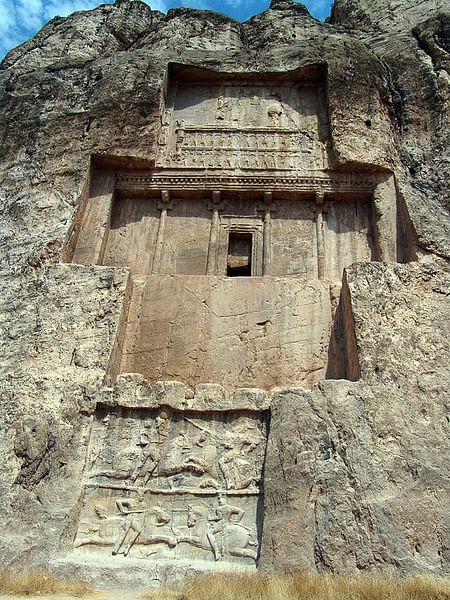
Darius's reign was one of the most important episodes in the history of the Persian Empire. His military conquest expanded the boundaries of Persia, and internally, his reforms improved the vitality of the empire. Some of his improvements have survived even to this day such as his laws as the basis for the current Iranian law.

